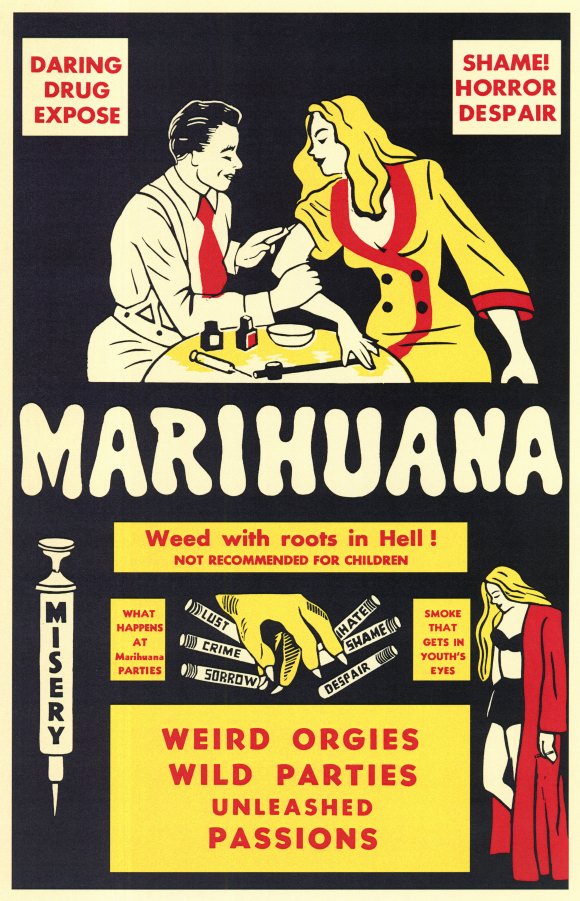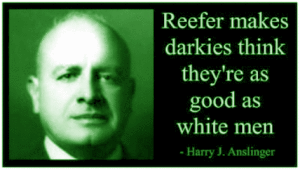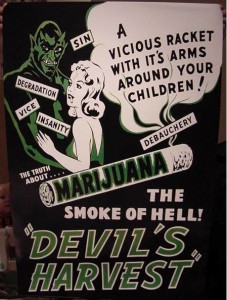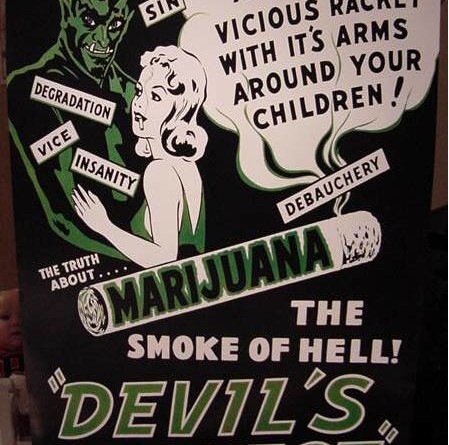When Marijuana Became Illegal in the United States
The implementation of The Marihuana Tax Act of 1937 is when marijuana became illegal in the United States. Before that, pretty much everyone knew what hemp was, but nobody knew what marijuana was. Cannabis Hemp was one of history's most widely used plants. Tincture of Cannabis was the basis for almost every patent medicine prior to the discovery of aspirin. Hemp (made from the stems or branches of the marijuana plant) was used for rope, twine, and cloth. Sailing ships were loaded with hemp. The word "canvas" is derived from "cannabis", because that's what canvas was. Sails were made of hemp because salt water deteriorated cotton. Old sails were made into wagon covers and ultimately original Levi's Jeans. And, the pressed oil from hemp seeds was used for paints and varnishes.

Basically, it came down to this. The United States in the 1900's saw two powerful rivals, agriculture and industry, face off over several multi-billion dollar markets. When Rudolph Diesel produced his engine in 1896, he'd assumed it would run off of vegetable and seed oils, especially hemp, which is superior to petroleum. Just think about that for a second. A fuel that can be grown by our farmers that is superior to foreign oil. What a lot of history would have been rewritten!

Ok. So we have an elite group of special interests dominated by Du Pont petrochemical company and its major financial backer and key political ally, Treasury Secretary Andrew Mellon. Mellon was a banker who took over Gulf Oil Corporation. In 1913, Henry Ford opened his first auto assembly line, and Gulf Oil opened its first drive-in gas station. In 1919, with ethanol fuel poised to compete with gasoline, Alcohol Prohibition descended on the nation. Lucky Mellon. When President Harding made him Secretary of the Treasury, he was considered the richest man in America. In the 1920's, Mellon arranged for his bank to loan his buddies as Du Pont money to take over General Motors. Du Pont had developed new gasoline additives and the sulfate and sulfite process that made trees into paper.
In the 1930's, Ford Motor Company operated a successful biomass fuel conversion plant using cellulose at Iron Mountain, Michigan. Ford engineers extracted methanol, charcoal fuel, tar, pitch ethyl-acetate and creosote from hemp. The same fundamental ingredients for industry were also being made from fossil fuels.
During the same period, Du Pont was developing cellophane, nylon, and dacron from from fossil fuels. Du Pont held the patents on many synthetics and became a leader in the development of paint, rayon, synthetic rubber, plastics, chemicals, photographic film, insecticides and agricultural chemicals.
From the Du Pont 1937 Annual Report we find a clue to what started to happen next: "The revenue raising power of government may be converted into an instrument for forcing acceptance of sudden new ideas of industrial and social reorganization".
Ok, enter William Randolph Hearst. Hearst's company was a major consumer of the cheap tree-pulp paper that had replaced hemp paper in the late 19th century. The Hearst Corporation was also a major logging company, and produced Du Pont's chemical-drenched tree pulp paper, which yellowed and fell apart after a short time. Fueled by the advertising sold to the petrochemical industries, Hearst Newspapers were also known for their sensationalist stories. Hearst despised poor people, black people, Chinese, Hindus, and all other minorities. Most of all he hated Mexicans. Pancho Villa's cannabis-smoking troops had reclaimed some 800,000 acres of prime timberland from Hearst in the name of the Mexican peasants. And all of the low-quality paper the company planned to make by deforesting its vast timber holdings were in danger of being replaced by low-cost, high quality paper made from hemp.
Hearst had always supported any kind of prohibition, and now he wanted cannabis included in every anti-narcotics bill. Never mind that cannabis wasn't a narcotic. Facts weren't important. The important thing was to have it completely removed from society, doctors, and industry.
Around 1920 or so, a new word arose - "Marihuana". Through screaming headlines and horror stories, "marihuana" was blamed for murderous rampages by "blacks and Mexicans". Hearst continued to use his power of the press to impress on his readers the dangers of the "marihuana" plant.
When the Federal Bureau of Narcotics was formed in 1932, Mellon's nephew Harry Anslinger was appointed its head, a job in Mellon's treasury department that was created just for him. Treasury agents were beginning to operate on their own agenda. Deep in the throes of the depression, congress began to reexamine all federal agencies. Anslinger began to fear that his department was in danger of emasculation. Although worldwide, hemp was still big business, in 1935 the Treasury Department began secretly drafting a bill called The Marihuana Tax Act.
 [The Marihuana Tax Act of 1937, Pub. 238, 75th Congress, 50 Stat. 551 (Aug. 2, 1937) went into effect October 1, 1937.] The Treasury Department's general counsel Herman Oliphant was put in charge of writing something that could get past both Congress and the Court disguised as a tax revenue bill. Congress wasn't all that interested in the matter, seeing as all the information they had to work with was what was provided to them by Anslinger. They deliberately collected horror stories on the evils of marihuana pulled primarily from the Hearst newspapers, called Anslinger's Gore Files. Crimes that had never happened at all were being attributed to marihuana.
[The Marihuana Tax Act of 1937, Pub. 238, 75th Congress, 50 Stat. 551 (Aug. 2, 1937) went into effect October 1, 1937.] The Treasury Department's general counsel Herman Oliphant was put in charge of writing something that could get past both Congress and the Court disguised as a tax revenue bill. Congress wasn't all that interested in the matter, seeing as all the information they had to work with was what was provided to them by Anslinger. They deliberately collected horror stories on the evils of marihuana pulled primarily from the Hearst newspapers, called Anslinger's Gore Files. Crimes that had never happened at all were being attributed to marihuana.
So, in 1937, Anslinger went before a poorly attended committee hearing and called for a total ban on marihuana. He stated under oath "This drug is entirely the monster Hyde, the harmful effects of which cannot be measured". Bureaucrats planned the hearings to avoid the discussion of the full House and presented the measure in the guise of a tax revenue bill brought to the six member House Ways and Means Committee, chaired by Du Pont ally Robert Doughton of North Carolina. This bypassed the House without further hearings and passed it over to the Senate Finance Committee, controlled by another ally, Prentiss Brown of Michigan, where it was rubber stamped into law. Once on the books, Anslinger would "administer" the licensing process to make sure that no more commercial hemp was ever grown in the United States. Clinton Hesterm assistant general counsel for the Department of the Treasury, explained to the House Committee " The leading newspapers of the United States have recognized the seriousness of this problem and have advocated federal legislation to control.. marihuana...The marijuana cigarette is one of the most insidious of all forms of dope, largely because of the failure of the public to understand its fatal qualities."
At the last minute, a few pro-hemp witnesses showed up. Most of the confusion came from the using of the word "marihuana". Most people had no idea that "marihuana", merely a slang word taken from a drinking song celebrating Pancho Villa's victory, "La Cucaracha", was the same thing as cannabis hemp, a plant which had been an important crop since the founding of the country.
Ralph Loziers of the National Oil Seed Institu te showed up representing paint manufacturers and lubrication oil processors, and stated that hempseed was an essential commodity. Dr. William C. Woodward of the American Medical Association spoke in defense of cannabis medicines and in protest of the way the bill was handled. Woodward complained that there was no certain data that marihuana use had increased, and stated that if it had, the "newspaper exploitation of the habit had done more to increase it than anything else". Asked point blank if he thought federal legislation was necessary, he replied "I do not .. it is not a medical addiction that is involved." Woodward went on to criticize the way the word "marihuana" had been used to deliberately confuse the medical and industrial hemp communities. "In all you have heard here thus far, no mention has been made of any excessive use of the drug or its excessive distribution by any pharmacist. And yet the burden of this bill is placed heavily on the doctors and pharmacists of the country, and may I say very heavily - most heavily, possibly of all - on the farmers of this country... We can not understand yet ... why this bill should have been prepared in secret for two years without any initiative, even to the profession, that it was being prepared ... no medical man would identify this bill with a medicine until he read it through, because marijuana is not a drug, ... simply a name given cannabis."
te showed up representing paint manufacturers and lubrication oil processors, and stated that hempseed was an essential commodity. Dr. William C. Woodward of the American Medical Association spoke in defense of cannabis medicines and in protest of the way the bill was handled. Woodward complained that there was no certain data that marihuana use had increased, and stated that if it had, the "newspaper exploitation of the habit had done more to increase it than anything else". Asked point blank if he thought federal legislation was necessary, he replied "I do not .. it is not a medical addiction that is involved." Woodward went on to criticize the way the word "marihuana" had been used to deliberately confuse the medical and industrial hemp communities. "In all you have heard here thus far, no mention has been made of any excessive use of the drug or its excessive distribution by any pharmacist. And yet the burden of this bill is placed heavily on the doctors and pharmacists of the country, and may I say very heavily - most heavily, possibly of all - on the farmers of this country... We can not understand yet ... why this bill should have been prepared in secret for two years without any initiative, even to the profession, that it was being prepared ... no medical man would identify this bill with a medicine until he read it through, because marijuana is not a drug, ... simply a name given cannabis."
A few days later, Representative Fred Vinson of Kentucky was asked to summarize the American Medical Association's position. He lied to the effect that the medical group's legislative counsel (Woodward) "Not only gave this measure full support, but also the approval from the AMA."
The act passed without a roll call vote, and that is when marijuana became illegal in the United States. Now we can see why it was prepared in secret - passage of the Act put all hemp industries firmly under the control of the very special interests that most benefited from its repression over the years - prohibition police and bureaucrats working in collusion with the petrochemical companies, the timber companies, the alcohol and tobacco industries, the pharmaceutical drug companies, and today, the urine testing, property seizure, police and prison industries.
 In that same year, 1937, Du Pont filed its patent on Nylon, a synthetic fiber that took over many of the textile and cordage markets that would have gone to hemp. More than half the American cars on the road were built by GM, which guaranteed Du Pont a captive market for paints, varnishes, plastics, and rubber, all which could have been made from hemp. Furthermore, all GM cars would subsequently be designed to use tetra-ethyl leaded fuel exclusively, which contained additives that Du Pont manufactured. All competition from hemp had been outlawed.
In that same year, 1937, Du Pont filed its patent on Nylon, a synthetic fiber that took over many of the textile and cordage markets that would have gone to hemp. More than half the American cars on the road were built by GM, which guaranteed Du Pont a captive market for paints, varnishes, plastics, and rubber, all which could have been made from hemp. Furthermore, all GM cars would subsequently be designed to use tetra-ethyl leaded fuel exclusively, which contained additives that Du Pont manufactured. All competition from hemp had been outlawed.
-----
From: How Marijuana Became Illegal by Bud Fairy (with minor revisions).
The historical essay above was written by "Bud Fairy" and originally published on SF Net the coffee house network. An HTML version - with minor editing - was done by Hogeye Bill.
For more background on the history of when marijuana became illegal in the United States, and reasons for the Marihuana Tax Act, see the following related documents from DrugPolicy.org:
The Marihuana Tax Act of 1937
The history of how the Marihuana Tax Act came to be the law of the land.
The History of the Non-Medical Use of Drugs in the United States - a speech by Professor Charles Whitebread to the California Judge's Conference - This contains a short history of the marijuana laws.
The Forbidden Fruit and the Tree of Knowledge, by Professors Richard Bonnie and Charles Whitebread - This is a more extended history of the origins of the marijuana laws.
Unraveling an American Dilemma: The Demonization of Marihuana - by John C. Lupien -- This is the best exploration I have seen of the background of the supposed Anslinger-Hearst-DuPont conspiracy to outlaw marijuana in order to remove hemp as a possible competitor to their products.
Correspondence about the legal status of hemp 1930-1938
Marihuana Tax Act - The full text of the Marihuana Tax Act, as passed in 1937
Conference on Cannabis Sativa L. January 14, 1937 -- Room 81 Treasury Building, 10:30 AM
Hearings on H.R. 6385
APRIL 27, 28, 29, 30, AND MAY 4, 1937
- Statement of Clinton M. Hester, Assistant General Counsel for the Department of the Treasury, and S.G. Tipton, Office of General Counsel
- Statement of H. J. Anslinger, Commissioner of Narcotics, Bureau of Narcotics, Department of the Treasury.
- Additional statement of H. J. Anslinger
- Letter from the Alamosa Daily Courier
- Marihuana - A More Alarming Menace To Society Than All Other Habit-Forming Drugs
- Marihuana as a Developer of Criminals, by Eugene Stanley, district attorney, parish of Orleans, New Orleans, La.
- Answers to Marihuana Questionnaire by Dr. W. L. Treadway Division of Mental Hygiene Public Health Service
- Additional Statement of Clinton M. Hester
- Statement of Dr. James C. Munch, Pharmacologist, Temple University
- Statement of Herbert J. Wollner, Consulting Chemist, Office of the Secretary of the Treasury
- Letters to the committee
- Statement of Dr. D. E. Buckingham, District Veterinarian, Washington, D.C.
- Statement of Hon. Ralph F. Lozier, Carrollton, Mo, General Counsel of the National Institute of Oilseed Products
- Further Statement of Clinton M. Hester, Assistant General Counsel, Treasury Department
- Additional Statement of Hon. Ralph F. Lozier, Carrollton, Mo, General Counsel of the National Institute of Oilseed Products
- Statement of Raymond G. Scarlett, Representing William G. Scarlett & Co., Baltimore, MD.
- Statement of Joseph B. Hertzfield, Manager, Feed Department, TGhe Philadelphia Seed Co., Philadelphia, PA
- Statement of Dr. William C. Woodward, Legislative Counsel, American Medical Association, Chicago, Ill.
- Statement of Dr. S. L. Hilton, Representing the American Pharmaceutical Assocation.
- Addenda -- Letter from Mrs. Hamilton Wright, special representative, Bureau of Narcotics
Hearing on H.R. 6906
July 12, 1937
Hearing Before a Subcommittee of the Committee on Finance United States Senate, Seventy-Fifth Congress, First Session on H.R.6906 - July 12, 1937
- Title Page, Members Present, Full text of H.R. 6906 (under construction)
- Statement of Clinton M. Hester, Assistant General Counsel, Treasury Department
- Statement of H. J. Anslinger, Commissioner of Narcotics, Bureau of Narcotics of the Treasury Department
- Statement of Matt Rens, Representing Rens Hemp Co., Brandon, Wis.
- Statement of Mr. Moksnes, Superintendent of the Amhempco Corporation, Danville, Ill.
- Statement of Royal C. Johnson, Attorney, Washington, D.C., Representing Chempsco, Inc. of Winona, Minn, and Hemp Chemical Corporation of Mankato, Minn.
- Statement of O.C. Olman, Representing Juneau Fibre Co., Juneau, Wis.
- Letter from the American Medical Association
Marihuana Conference
Held on December 5, 1938 in the UNITED STATES Bureau of Internal Revenue Building (Room 3003), Washington D. C., Called by the Bureau of Narcotics of the United States Treasury Department. (Complete document. Parts are listed below.)
- Conferees Present.
- Opening Statement by H. J. Anslinger, Commissoner of Narcotics
- Statement of Dr. A. H. Wright, Professor of Agronomy, University of Wisconsin, relating to growth of Hemp, where seeds are produced, and Hemp is grown in United States.
- Statement of Mr. Franklin. Chief of Drug Control, State of New York as to growth of Marihuana in that state.
- Statement of Dr. B. B. Robinson, Bureau of Plant Industry, Department of Agriculture, relative to experiments as to World Production of Hemp, and quantity of Production in United States and Growth and Production of Cannabis, and Comparative Results obtained from Seed obtained from various Countries.
- Statement of Dr. John R. Matchett, Chief Chemist, Bureau of Narcotics, as to Tests made from Seeds of Hemp in various Countries.
- Statement of Mr. Henry Fuller, Consulting Chemist, as to his Experience in Growth of Cannabis.
- Statement of Dr. James C. Munch, Professor of Pharmacology, Temple University, relating to Effects of Marihuana on Organs of Body:
- Statement of Dr. S. Loewe, Pharmacologist, Cornell University Medical College, as to Bio-Assay of Marihuana
- Statement of Dr. Walter Bromberg, Senior Psychiatrist, Department of Hospitals, New York City, relating to varying Effects of Marihuana in various Classes of Individuals.
- Discussion on Pharmacological Phases of Marihuana Problem.
- Statement of H. J. Wollner, Consulting Chemist, Treasury Department
- Statement of Dr. A. H. Blatt, Howard University, Relative to Survey of Chemical Constituents of Cannabis Sativa.
- Statement of Dr. John R. Matchett, Treasury Department, containing Report of Department of Attacks on Marihuana Problems.
- Statement of Dr. Joseph Levine, Chemist, Bureau of Narcotics, as to Tests for Identification of Marihuana
- Statement of Mr. Louis Benjamin, Chemist, Treasury Department, as to Tests.
- Statement of Dr. James C. Munch, as to Tests.
- Statement of Dr. H. M. Lancaster, Chief Dominion Analyst, Canadian Government, in relation to Tests.
- Statement of Dr. James Couch, Pathological Division, Bureau of Animal Industry, Department of Agriculture
Correspondence about the legal status of hemp 1930 - 1938
Letter from Harry Anslinger - September 29, 1936
Letter from Elizabeth Bass - September 30, 1936
Letter from Elizabeth Bass - October 6, 1936
Letter from Harry Anslinger - November 2, 1936
Letter from Elizabeth Bass - November 3, 1936
Day By Day Story of the Experimental Farms - Process Cured Hemp - by Frank Ridgway, Chicago Tribune, November 4, 1936
Letter from Elizabeth Bass - November 5, 1936
Letter from Elizabeth Bass - November 6, 1936
Report of the Marihuana Investigation - Summer, 1937
Day By Day Story of the Experimental Farms - Process Cured Hemp - by Frank Ridgway, Chicago Tribune, October 10, 1937
Letter from H. W. Bellrose, October 12, 1937
Letter from H. W. Bellrose - October 12, 1937
Letter from H. W. Bellrose - October 14, 1937
Letter from Brien McMahon - October 26, 1937
Letter from Will S. Wood - November 6, 1937
Letter from Frank Ridgway - January 21, 1938
Letter from Elizabeth Bass - March 5, 1938
Letter from Elizabeth Bass - March 5, 1938
Letter from Elizabeth Bass - March 10, 1938
Report of Survey Commercialized Hemp Crop (1934-35 Crop) in the State of Minnesota, by H.T. Nugent, Federal Bureau of Narcotics, Field Supervisor, October 22, 1938

